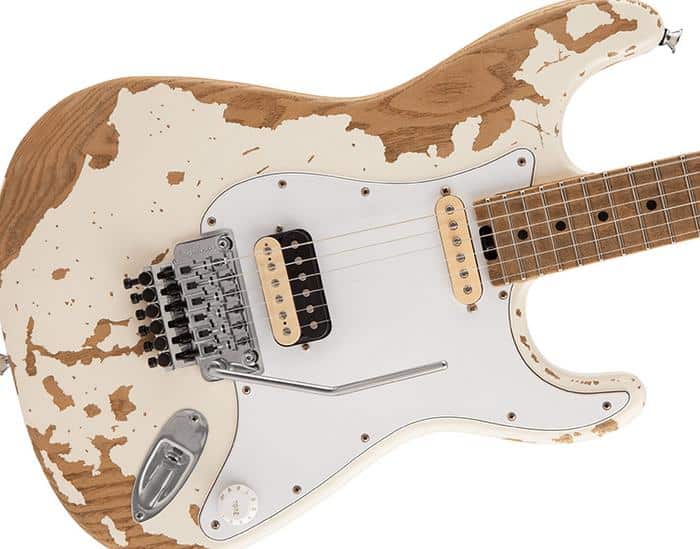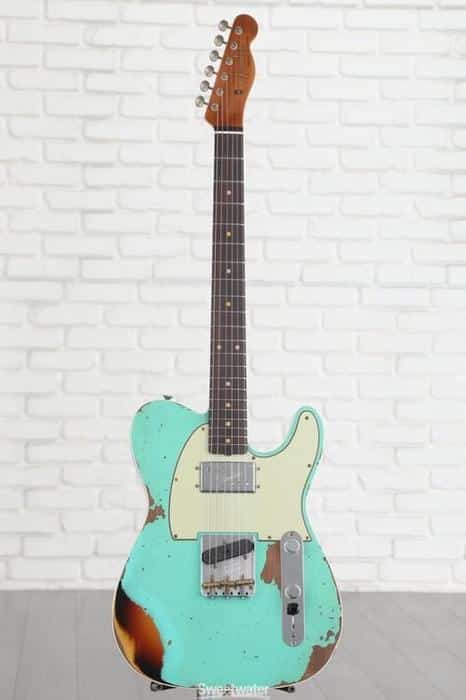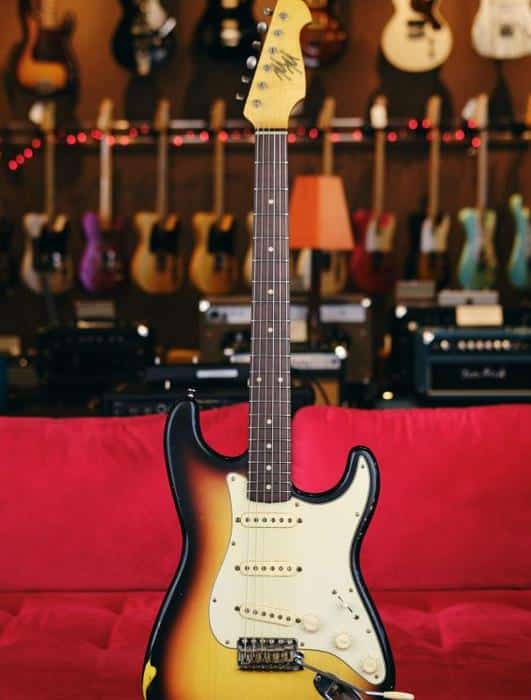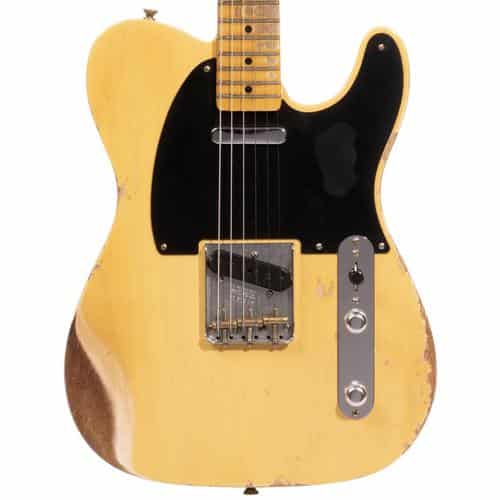Picture this: Jimmy Page, hand on the neck of a once-pristine guitar, now beautifully beaten and bruised, each scratch and crack telling a tale of countless concerts and power-packed performances. As a pivotal figure in the guitar community, I’ve always been intrigued by aged, or ‘relic’d guitars’, and their undeniable charm. This allure steered me onto an unparalleled path of exploration, one that examined these timeworn jewels in their entirety, from their formation to their increasing popularity.
My name is Michael Brown, and my undying love for guitars has taken me on many journeys, the journey through the world of relic’d guitars being one of the most captivating. For those unaware, these are guitars made aged artificially to mimic the natural wear and tear it would usually acquire over years of use, imbuing both nostalgia and vintage aura.
In this comprehensive analysis, I shed light on every unique aspect of these aged beauties – the homage to bustling Rock ‘n’ Roll era, the artistry of relic’ing, and even the deep-set controversy that surrounds them. The world of relic’d guitars is both mystifying and intriguing, filled with battles for authenticity and clinging to nostalgia. And as we delve deeper, together, we’ll untangle the intricacies that make this world a treasure in itself.
So, whether you are a veteran guitarist, an intrigued beginner, or a passionate enthusiast, come with me as we navigate the winding roads of relic’d guitars, understanding their diverse facets and appreciating the charm that lies within their well-worn strings.
Understanding Relic’d Guitars
Defining Relic’d Guitars

As we dive further into the enigmatic domain of relic’d guitars, one question that often emerges is – what exactly are these intriguing instruments? Framing a sound definition is essential to capture their true essence.
Relic’d guitars, at their core, are guitars that are artificially aged to mirror the wear and tear of a vintage instrument that has been used for decades. From my own personal experience, the allure of these guitars lies in their worn-out aesthetics, reflective of countless jamming sessions and recording memories, thereby evoking a strong sense of nostalgia and timelessness.
The process of creating such guitars involves thoughtful distressing and aging, both visually and sonically. This includes everything from strategic nicks and scratches, to purposeful discolorations and for some, even purposely degrading the sound quality to mimic vintage tonal characteristics.
Having said this, it is essential to note that relic’d guitars are not merely “used guitars.” They are modern instruments, deliberately aged with a craftsman’s touch, to boast history and character that is usually associated with a well-loved, well-played guitar. Each relic’d guitar, thus, tells a story of its own, making it unique in a universe of mass-produced instruments.
What initially piqued my interest in these artificially aged guitars, was the perfect blend of the old world charm with modern-day precision and technology. They offer the best of both worlds – the allure and mystique of a vintage piece, with the reliability and efficiency of a modern instrument.
When approached with an open mind, relic’d guitars frequently contradict our traditional understanding of ‘newness’ while making a profound statement about the value of age, experience, and history in music.
As we delve deeper into this topic, it’s essential to understand that these relic’d guitars are more than a tool for replicating the past. They are instruments of artistry that celebrate the enduring allure of rock ‘n’ roll, symbolising the spirit of rebellion and freedom that has captivated generations of musicians and fans alike.
Pivoting from this understanding of relic’d guitars, our next step in this comprehensive exploration is examining the art that goes into the creation of these instrumental masterpieces. Reading on, you will get a glimpse into the meticulous process of crafting a relic’d guitar, taking you a step closer to appreciating these fascinating instruments.
The Art of Relic’ing Guitars

Following up on our exploration of ‘Understanding Relic’d Guitars’, we immerse ourselves into the beautiful world of creating these pieces, the remarkable ‘Art of Relic’ing Guitars’. Over the years, I’ve been privileged to witness this process first-hand from some of the best luthiers in the business, and it’s this journey I am delighted to share with you.
At the heart of the relic guitar process is the pursuit of authenticity.> Authenticity not just in sound, but in form and feel. The process begins by understanding what the original guitar would have looked like, including knowing the minute details such as the specific type of finish used during the guitar’s era.
Subtle ageing techniques are meticulously employed at various stages. This could range from slightly worn paint areas, to more dramatic techniques to mirror decades-old crack lines in the finish, and even carefully calibrated cigarette burns. I remember watching a seasoned luthier use a tiny dental drill to accurately recreate wormholes that would naturally appear over time. The attention to detail is staggering, showcasing the authenticity strived for in this craft.
Skilled luthiers continuously evaluate and adjust their technique to ensure they translate natural age and wear into their work realistically. They experiment with different types of abrasives, application techniques and how to accelerate the natural oxidisation process of metal parts. No two relic’d guitars are identical, because no two guitars age the same way.
But beneath the aesthetics, the relevance of the art of relic’ing guitars lies in its profound respect for history and its ability to tell a story. These guitars bear the marks of countless hours of playing, paying tribute to the music that has been, and longing for the music yet to be.
We now understand that relic’d guitars are not just about an antique look or recreated vintage sound. They are about an inimitable character, a soul. This tangible connection to a musical past makes each relic’d guitar special. In the next section, we delve into how these recreated musical pieces also stir up some controversies in the guitar world.
The Controversy Surrounding Relic’d Guitars

After years of analyzing trends, ideas, and polemics in the complex world of guitars for Guitar Player magazine, I have come to respect and value controversy. Not merely as a source of disagreement, but as a catalyst for stimulating discussions and expanding knowledge. In this regard, the relic guitar controversy holds a fascinating element of debate.
The process of artificially aging a guitar to create what is known as a ‘relic’d guitar’ often stir strong emotions within the guitar community. This process, also known as faux aging, gives the guitar a worn-in vintage look, one that many players find appealing.
Is it justified to artificially distress a piece of craftsmanship or is it merely a clever deception? Let’s delve into the heated debates surrounding relic’d guitars.
On one side of the argument, you have purists who view the practice of relic’ing as nothing short of sacrilege. To them, each scratch, dent, and mark on a guitar should tell a personal story, a testament to the journey of the musician, mirroring the life they have lived and the music they have created. Fake vintage guitars represent a dishonest narrative.
On the other side of the debate, proponents argue that faux-aged guitars offer individuals the aesthetic appeal of a vintage instrument without the hefty price tag. They contend that the process is similar to buying jeans that are pre-faded or furniture that is distressed to appear antique. It’s about the look and the vibe, rather than an attempt to deceive.
My personal stance on the matter? Well, as a writer and guitarist, I appreciate both perspectives. This isn’t about declaring a ‘right’ or ‘wrong’. It’s about personal preference, artistic expression, and market demand. However, the essence of the controversy perhaps lies not in the process of relic’ing, but rather in how it is presented to the buyer – transparency is key.
While it’s true that faux aging can mislead the uninformed, manufacturers and sellers of relic’d guitars need to ensure that potential buyers are aware they are getting a masterfully aged instrument, not a neglected vintage piece. This is where ethical marketing comes into play, shaping the boundary between creative design and deceptive practice.
Personally, my journey with relic’d guitars is far from over. Every dip and crater remind me of a story to be woven, whether real or fabricated. Whilst some view the relic guitar controversy with heated passion, I see it as a gateway, opening new dimensions in the world of guitars. It’s a conversation that’s far from exhausted, offering more space for exploration and understanding.
As we continue to dig deeper into the world of relic’d guitars in the coming sections, let’s remember the beautiful complexity that lies at the heart of this controversy. After all, aren’t the greatest crafts built on the foundations of passionate debate and fierce individuality?
Benefits of Owning Relic’d Guitars

Immersing myself in the world of relic’d guitars has been one of the most rewarding experiences of my life. The essence of a well-worn, battle-scarred guitar, imbued with decades of musical heritage, yet built just yesterday, invokes a profound sense of nostalgia and intrigue. In my years of exploring this unique branch of guitar craftsmanship, I have discovered numerous relic guitars benefits that I believe can enhance any guitarist’s musical journey.
My inaugural acquaintance with a relic’d guitar was a momentous encounter. The patina. The imperfections. The seasoned feel. That authentic vintage guitar look that made me instantaneously feel connected to generations of music masters. Yet, it was not just an old guitar. It was a pristine musical instrument, fresh off the assembly line, primed to produce unparalleled sound quality with its modern design elements. It was in this moment I asked myself, “What if you could have the charm of a vintage guitar with all the functionalities of a modern one?” That’s when I knew I was hooked onto something extraordinary.
Undoubtedly, one of the key reasons why choose a relic’d guitar is the way they masterfully blend the old and the new. Each one’s unique character comes from the attention to detail during the artful process of relic’ing, offering the aesthetics of an older model, while preserving the excellent playability of a new instrument. The softened edges, the custom wear and the comforting grip all add to its overall allure, letting you feel the echoes of the musical past while playing in the present.
Relic’d guitars also tend to have superior playability, even more than their vintage counterparts. Years of ongoing technological progress have seen improvements in string specifics, truss rod design, neck curvature, and other technical aspects. Relic’d guitars incorporate these advancements, ensuring that you not only have a guitar that looks old but one that feels and plays better than most vintage models.
An additional perk lies within the personalization aspect. Owning a guitar that mimics decades of love and wear can make you feel like you’re in possession of a unique piece of musical history. Each dent, ding, scratch, or finish checking is custom-created, ensuring no two relic’d guitars are the same.
In essence, the greatest advantage of a relic’d guitar is the simultaneous sense of history it imparts along with the guarantee of consistent performance. It offers the best of both worlds – a segment of music’s past and the prospect of its future, inextricably intertwined in a unique instrument.
My personal feelings aside, it’s undeniable that relic’d guitars are mired in controversy within the music world. Yet, I fervently believe that the aesthetic allure, the enhanced playability, and the sense of individuality these guitars provide play a crucial role in shaping one’s musical journey. In further sections, we will explore popular relic’d guitar models, their pricing, and address frequently asked questions. For now, I conclude with the note that this unique charm and blend of modern functionality wrapped up in a vintage appearance truly sets relic’d guitars apart. The benefits of owning one are inextricably tied to the personal musical journey each player undertakes. And it is a journey that I, for one, heartily endorse.
Popular Relic’d Guitars and Their Price Range
Famous Relic’d Guitar Models

As a passionate guitar enthusiast with years of experience playing and reviewing various guitar models, the opportunity to delve into the realm of relic’d guitars has been a personal highlight for me. When discussing relic’d guitars, no conversation can be complete without mentioning the renowned models like the Fender Custom Shop relic, relic’d Telecaster, and the relic’d Stratocaster.
The Fender Custom Shop relic guitars hold a special place among relic’d guitars, offering a time-traveling experience. These models acutely capture the aesthetic of well-worn instruments, paying homage to guitars that bear the marks, nicks, and scratches of a life dedicated to music. From the original introduction of this model, many guitar enthusiasts appreciated its authenticity.
Let’s dive further into my personal experiences with these masterpiece models. A personal favorite of mine is the relic’d Telecaster. Its wear spots and weathered finish bring a unique character that appeals to me as a player. Its vintage-inspired sound, charm, and soul are authentic and impressive. The price range for such guitars is usually on the premium side due to the high demand, elaborate craftsmanship, and rarity.
Next, the much coveted relic’d Stratocaster. There’s something magical about playing a guitar that looks and feels as if it has a story to tell. Its worn-in feel and the unique aging process applied to its exterior make it more than just a musical instrument; it’s a piece of art. It’s priced slightly higher than the relic’d Telecaster, and it rings true to the old adage – you get what you pay for.
I’m a firm believer in the value these relic’d guitars bring. It’s more than just about the age, it’s about the history, soul, and the stories they are imbued with. While some people may see them as mere guitars, I see them as treasured companions that have stood the test of time. Whether it’s the Fender Custom Shop relic, the relic’d Telecaster or the relic’d Stratocaster, each of these models has significantly contributed to the popularity and demand of relic’d guitars. So now, as we venture further into the pricing of relic’d guitars, keep in mind the priceless emotional value they hold for us players.
Pricing of Relic’d Guitars

Transitioning from the notable models of relic’d guitars, it is fitting to delve into the pricing of such instruments. Through years of straddling the worlds of journalism and guitar enthusiasm, I’ve gathered a comprehensive understanding of relic’d guitar prices. Let’s explore this compelling factor together.
As a time-honoured tradition in the guitar world, relic’ing isn’t just about creating a vintage look. It’s about manufacturing a nostalgic feel and audio character that begs for a guitarist’s touch. The meticulous craftsmanship involved directly feeds into the pricing of relic’d guitars.
Analysing the market, we can see that relic’d guitar prices vary dramatically. This price range spans from a few hundred to several thousand dollars, influenced by factors not dissimilar to those affecting pristine guitars. Brand reputation, type of relic’ing, quality of materials, and the level of craftsmanship employed in both building and aging the guitar — all contribute to the final price tag. When purchasing a relic’d guitar, you are in essence paying for the expertise that goes into mimicking the wear patterns of a well-loved instrument.
Although immediately premium, remember that each scuff, scratch, and dent is manually added and treated to accurately replicate years of playing, translating into higher labour costs. Fundamentally, relic’d guitars are not just instruments; they are pieces of fine art.
So why the vast price range? While brand reputation and quality remain constant contributors, the actual process of relic’ing plays a significant part. Handmade relic’ing processes are generally more expensive due to the time and artistry involved. Cost-effective alternatives are not left behind though, thanks to skilled craftsmen who’ve found ways to streamline the process without compromising on authenticity.
In essence, the pricing of relic’d guitars goes beyond the surface. The cost reflects the patience, skill, and passion poured into creating a seemingly played and loved instrument, while ensuring great playability and tone that a musician craves. Each relic’d guitar narrates its unique story through its physical wear, and trying to put a price on that is a complex task.
Whether the relic’d guitar prices seem reasonable or not, it’s a subjective matter. For some, the vintage aura, nostalgic feel and unique character justify the cost. For others, the appeal might lie in a cheaper, pristine guitar and allowing time to tell its own tale.
Moving forward, we delve into the question that often follows the topic of relic’d guitar prices – What are some of the most famous relic’d guitar models? Bear with me as we venture into this exciting subsection.
FAQs
What is a Relic’d Guitar?
Why are Relic’d guitars popular?
Who makes the best Relic’d guitars?
How are Relic’d guitars made?
Conclusion
As we ever-so-slowly draw the curtains on this deep dive into the universe of relic’d guitars, I must confess, these venerable instruments have grown on me in more ways than one. With their unique aesthetic of an aged finish, reflective of countless on-stage hours and untold tales of rock ‘n’ roll, I’ve come to appreciate the distinct character each relic style guitar embodies. How their soul-stirring charm and the unfeigned wear-and-tear coax out a raw, unfiltered sound, brimming with history.
Whether you agree with the concept or not, one can’t deny that relic’d guitars have carved a unique niche in music history! Across roles ranging from defining the special flair of guitar virtuosos to sparking heated debates on artificial ageing, these instruments have spotlighted themselves. But at their core, they remain guitars – stringed storytellers, waiting to be embraced, ready to belt out melodies. So, is there a relic’d guitar story in your future?
Treading the fine line between the unvarnished beauty of genuine vintage and the convenience of contemporary technology, relic’d guitars find themselves in a unique space. Very much like vintage wines aged to perfection, equipped with stories aplenty. They don’t just transform sound; they transform the guitarist, urging an unseen bond based on stories, trust, precision, and countless jamming sessions. A relationship, an understanding, a journey. And that, my friend, is the undeniable allure of relic’d guitars.
Right from understanding the ins and outs of relic’d guitars, immersing ourselves in the art of relic’ing, exploring popular models, discussing the controversy they attract, to appreciating their benefits, we’ve traversed it all. I sincerely hope this comprehensive exploration has inspired you to look at these well-loved relics in a new light.
As we wrap up, I hope to encapsulate the charm and appeal of relic’d guitars that have left an indelible imprint on my journey with guitars. Like complex melodies woven into music history’s fabric, each relic’d instrument unearths a story impregnated with passion and time. They are, but an echo of the fabled tales spun around backstage jam sessions, dusk-till-dawn concerts, and the evolution of music. And, I trust this guide will inspire you to seek your own unique guitar story.
A story that resonates with the chords of your soul; a story that’s as heartfelt as the music you aspire to create. In the world of guitars, we remain perpetual students, and relic’d guitars, fascinating artifacts, worth our time, exploration, and deep understanding!
